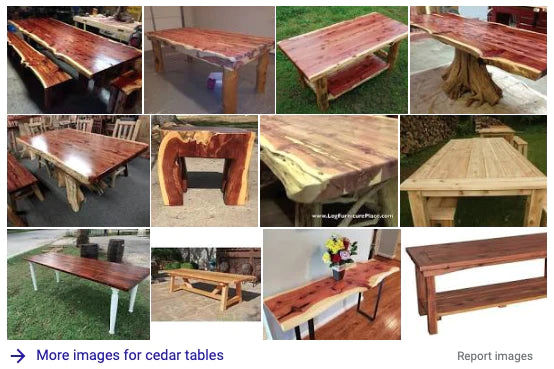“Cedar” can be a confusing wood because most trees we’d consider to be cedar aren’t from the species cedrela. For example, Eastern red cedar, by its scientific name Juniperus virginiana L., is actually from the species juniper, as the moniker indicates. However, Eastern red cedar is the tree responsible for most of the cedar lumber encountered in furniture in the U.S.
Five of the most common types of cedar trees are covered below.
1. Eastern Red Cedar (Juniperus virginiana L.)
Eastern red cedar trees are found all over the East Coast and stretching as far West as Nebraska. This species produces the most durable wood of the all the varieties listed here. It's also the one most commonly found in furniture, flooring, and siding in the US.
2. Eastern White Cedar (Thuja occidentalis L.)
Eastern white cedar is a light brown softwood that grows in the Northeastern U.S. and Southeastern Canada. Like others of the species Thuja, it’s associated with health conditions like asthma, convulsions and miscarriage. It’s also the least dense and most susceptible to damage, with a rating of 320 Janka.
3. Spanish Cedar (Cedrela oderata L.)
As the “cedrela” name indicates, Spanish cedar is the only true cedar of this group, but it’s also not used often. Spanish cedar is a pink or reddish-brown hardwood that grows in Central and South America. With a rating of 600 Janka, it was historically used as an alternative to teak or eastern red cedar. However, excess harvesting resulted in Spanish cedar trees being categorized as “vulnerable” to extinction. As such, many countries have preemptively established regulations which limit harvesting and exporting in an effort to preserve the species. Unfortunately, illegal harvesting and importation remains a problem.
4. Western Red Cedar (Thuja plicata)
Western red cedar is oddly not even the same species as eastern red cedar, despite the fact that the common names are similar. Compare their scientific names (Thuja vs. Juniperus) and it’s easy to see this. Being of the Thuja species, it comes with the same health risks as eastern white cedar too.
Western red cedar is a softwood with a reddish-brown hue, looks similar to eastern red cedar, and has many of the same weather-resistant and insect-repelling properties as eastern red, so it sometimes passes as a doppelganger and gets used in outdoor furniture as well. However, with a 350 Janka rating, it’s far less resilient than eastern red cedar. It also only grows across the westernmost portions of North America.
5. Alaskan Yellow Cedar (Palicourea croceoides)
Yellow cedar is a yellowish hardwood that only grows on the Western coastline of North America. Climate change is destroying its natural habitat and, as such, populations are dwindling. Scientists and environmentalists are currently working on ways to halt this phenomenon, known as “Yellow-Cedar Decline,” but have had little success. With a 580 Janka rating, yellow cedar has historically been used for things like boat-making and even stringed instruments, though this is seen far less now over environmental concerns.
Read more about cedar wood.


